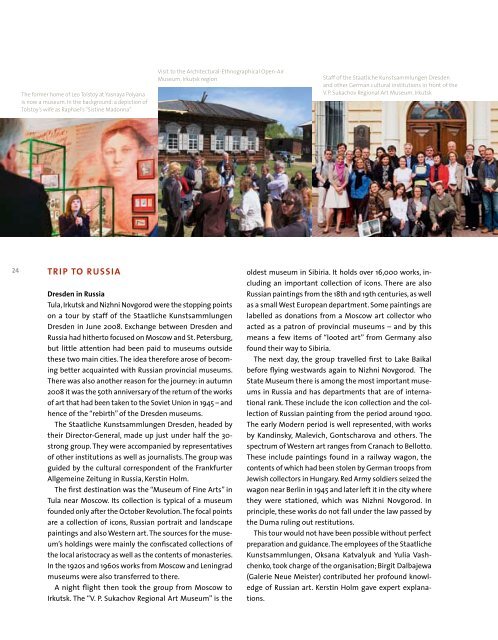2008 - Staatliche Kunstsammlungen Dresden
2008 - Staatliche Kunstsammlungen Dresden
2008 - Staatliche Kunstsammlungen Dresden
You also want an ePaper? Increase the reach of your titles
YUMPU automatically turns print PDFs into web optimized ePapers that Google loves.
The former home of Leo Tolstoy at Yasnaya Polyana<br />
is now a museum. In the background: a depiction of<br />
Tolstoy’s wife as Raphael’s “Sistine Madonna”<br />
24 TRiP TO RUssiA<br />
Visit to the Architectural-Ethnographical Open-Air<br />
Museum, Irkutsk region<br />
<strong>Dresden</strong> in Russia<br />
Tula, Irkutsk and Nizhni Novgorod were the stopping points<br />
on a tour by staff of the <strong>Staatliche</strong> <strong>Kunstsammlungen</strong><br />
<strong>Dresden</strong> in June <strong>2008</strong>. Exchange between <strong>Dresden</strong> and<br />
Russia had hitherto focused on Moscow and St. Petersburg,<br />
but little attention had been paid to museums outside<br />
these two main cities. The idea therefore arose of becoming<br />
better acquainted with Russian provincial museums.<br />
There was also another reason for the journey: in autumn<br />
<strong>2008</strong> it was the 50th anniversary of the return of the works<br />
of art that had been taken to the Soviet Union in 1945 – and<br />
hence of the “rebirth” of the <strong>Dresden</strong> museums.<br />
The <strong>Staatliche</strong> <strong>Kunstsammlungen</strong> <strong>Dresden</strong>, headed by<br />
their Director-General, made up just under half the 30strong<br />
group. They were accompanied by representatives<br />
of other institutions as well as journalists. The group was<br />
guided by the cultural correspondent of the Frankfurter<br />
Allgemeine Zeitung in Russia, Kerstin Holm.<br />
The first destination was the “Museum of Fine Arts” in<br />
Tula near Moscow. Its collection is typical of a museum<br />
founded only after the October Revolution. The focal points<br />
are a collection of icons, Russian portrait and landscape<br />
paintings and also Western art. The sources for the museum’s<br />
holdings were mainly the confiscated collections of<br />
the local aristocracy as well as the contents of monasteries.<br />
In the 1920s and 1960s works from Moscow and Leningrad<br />
museums were also transferred to there.<br />
A night flight then took the group from Moscow to<br />
Irkutsk. The “V. P. Sukachov Regional Art Museum” is the<br />
Staff of the <strong>Staatliche</strong> <strong>Kunstsammlungen</strong> <strong>Dresden</strong><br />
and other German cultural institutions in front of the<br />
V. P. Sukachov Regional Art Museum, Irkutsk<br />
oldest museum in Sibiria. It holds over 16,000 works, including<br />
an important collection of icons. There are also<br />
Russian paintings from the 18th and 19th centuries, as well<br />
as a small West European department. Some paintings are<br />
labelled as donations from a Moscow art collector who<br />
acted as a patron of provincial museums – and by this<br />
means a few items of “looted art” from Germany also<br />
found their way to Sibiria.<br />
The next day, the group travelled first to Lake Baikal<br />
before flying westwards again to Nizhni Novgorod. The<br />
State Museum there is among the most important museums<br />
in Russia and has departments that are of international<br />
rank. These include the icon collection and the collection<br />
of Russian painting from the period around 1900.<br />
The early Modern period is well represented, with works<br />
by Kandinsky, Malevich, Gontscharova and others. The<br />
spectrum of Western art ranges from Cranach to Bellotto.<br />
These include paintings found in a railway wagon, the<br />
contents of which had been stolen by German troops from<br />
Jewish collectors in Hungary. Red Army soldiers seized the<br />
wagon near Berlin in 1945 and later left it in the city where<br />
they were stationed, which was Nizhni Novgorod. In<br />
principle, these works do not fall under the law passed by<br />
the Duma ruling out restitutions.<br />
This tour would not have been possible without perfect<br />
preparation and guidance. The employees of the <strong>Staatliche</strong><br />
<strong>Kunstsammlungen</strong>, Oksana Katvalyuk and Yulia Vashchenko,<br />
took charge of the organisation; Birgit Dalbajewa<br />
(Galerie Neue Meister) contributed her profound knowledge<br />
of Russian art. Kerstin Holm gave expert explanations.

















